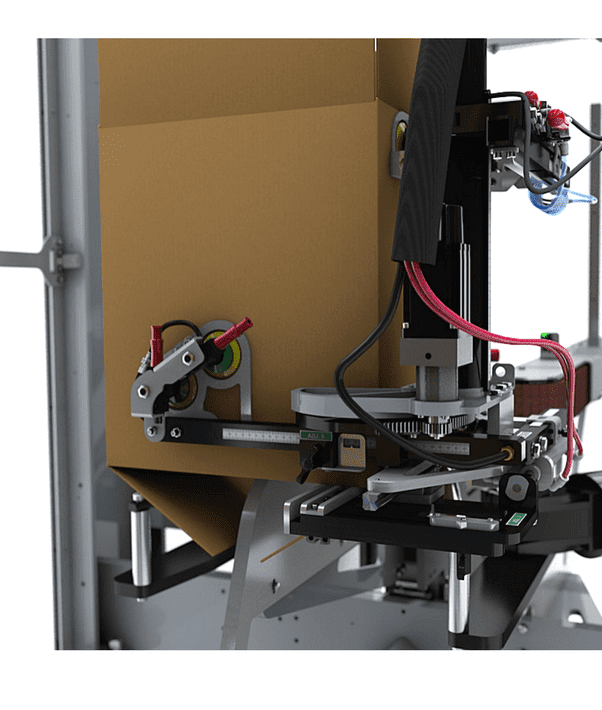Robotic case erectors: How they compare to traditional case erectors
Published March 16, 2021

Like any secondary packaging machinery, a case erector is a major investment. It’s not just the initial expenditure. Selecting a machine with the best performance and efficiency influences your end-of-line production for years to come. When choosing between a traditional case erector and one that uses robotic movement, it can be difficult to sort fact from fiction. To start the decision process, consider comparing the following important features of these two types of case erectors.
Mechanical parts
A case erector with robotic arm pick-and-pass movement is certainly eye-catching and futuristic. At the same time, this design provides important advantages to the production floor. Top of the list is the fact that SCARA robotic movement requires fewer parts and components to operate than a traditional case erector — as much as 40-50% less. Here’s how it can get by with fewer parts:
- The robotic arm can perform the same task across multiple case types and sizes. That means there are dramatically fewer components to switch during a changeover. It’s mostly controlled by programming.
- Fewer parts means more accessibility, increased sanitation, less noise and more safety. Combined, this means getting your operators and maintenance personnel trained quickly.
[Read more about the advantages of a case erector with robotic arm movement]
Fewer parts also translates into fewer maintenance tasks, fewer opportunities for breakdowns, more uptime and lower overall operational costs.
Changeovers
Traditional case erectors generally require more machine tuning and adjustments during changeover.
Robotic case erectors utilize high repeatability from servo-controlled movements. This dramatically reduces the need for tuning and adjusting to get the line running again, improving overall uptime.
Footprint
Square footage isn’t a luxury in a production space. Facilities are a significant expense for manufacturers of consumer-packaged goods, meaning cost per square foot is a critical metric. In a plant with limited floor space, a traditional case erector with more mechanical parts will occupy a larger footprint compared to a SCARA robotic case erector. For example, the maximum size of INSITE Packaging’s E20T case erector is under 13’ x 5’.
Lower decibels
A SCARA robot in operation is quieter than the mechanical parts of traditional case erectors. Having fewer mechanical parts with a smoother machine movement lowers the decibel level on the production floor.
Case handling
Case erectors usually use one of three methods to open a case: pin and dome, traditional vacuum or opposing cup vacuum. With pin and dome, the machine inserts the pin into the flute of the corrugated blank, giving it leverage to open the case and ready it for squaring. Some tout pin and dome as the ideal method because it uses a tool rather than vacuum to open the case. Traditional vacuum, opposing cup vacuum and pin and dome methods are comparable in maintenance.
Pin and dome and traditional vacuum may work well if the corrugated is in pristine condition. In reality, conditions of the case blanks can change. They can:
- become warped in high humidity
- become bent or crushed at the edges
- have variations in material tolerance
Because of these imperfections, the pin can often miss the flute using pin and dome. As a result, the case can’t open, causing the machine — and the line — to come to a halt. For that reason, pin and dome is not always the most efficient solution in a case former.
Pin and dome opening systems tend to be less effective with other imperfections in the corrugated as well. A batch of corrugated blanks with thinner than normal stock can result in higher than normal ripped cases, lower throughput and lower efficiency.
Traditional vacuum may afford more forgiveness in the corrugated blank as pins are rigid and vacuum cups are pliable. Cleaning cups and filters do take maintenance; however, pins can bend and break, making the maintenance comparable to that of vacuum. Traditional vacuum opens the case from only one side, which lowers efficiency.
A Rockwell-controlled robotic arm of an INSITE case erector uses opposing cup vacuum to positively open blanks from both sides of the case. This method provides an efficient solution to glue overspray that may occur on the manufacturer’s joint that prevents the case from opening. It also allows the erector to handle corrugated blanks with tolerance variations at a higher success rate and with greater reliability. Combined, this improves your overall efficiency and throughput — and lets you keep your attention on other areas of production.
Contact INSITE Packaging today and learn more about how automation can improve your line.